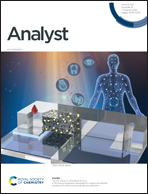Quantitative 1H-NMR spectroscopy as an efficient method for identification and quantification of PVC, ABS and PA microparticles†
Abstract
As an extension of the new, size-independent, fast and easy quantitative 1H-NMR (qNMR) spectroscopy as an alternative method for microplastic (MP) analysis we herein present the possibility to analyze three environmentally highly relevant MP particles by qNMR spectroscopy. The investigations cover polyvinyl chloride (PVC) powder with a size <50 μm, acrylonitrile butadiene styrene (ABS) granules with a size distribution of 100–300 μm, and polyamide (PA) fibres with a length of approx. 500 μm and a diameter of approx. 20–30 μm. For quantification, the integration method or the peak-fitting method combined with the calibration curve method was used. Linearity above 0.99R2, precision of 99.1–99.9% and accuracy of 95.6–110% for all three polymer types demonstrate the high analytical potential of the method. Moreover, the limit of detection (40–84 μg mL−1) for all polymer types is in the lower environmentally relevant range.



 Please wait while we load your content...
Please wait while we load your content...